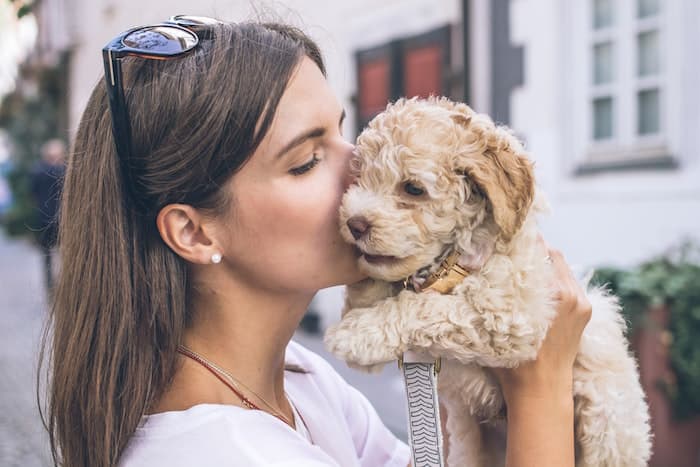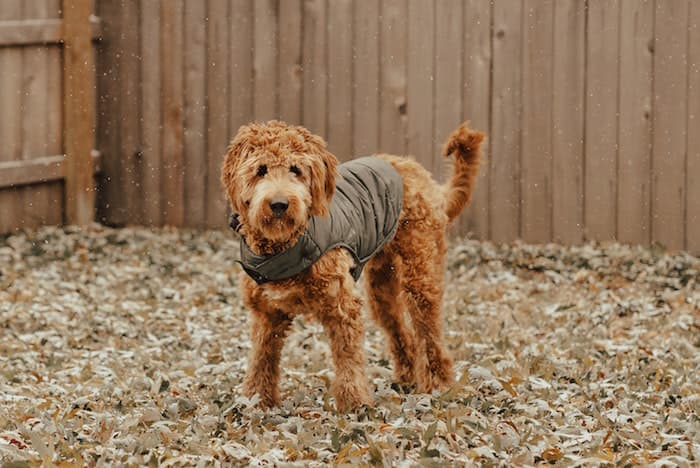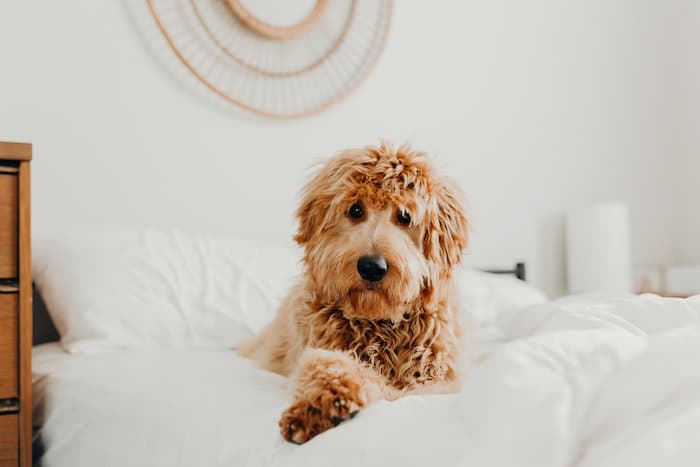Goldendoodles have grown in popularity over the years due to their charming personalities, playful demeanor, and cute appearances. With the increasing number of Goldendoodle puppies for sale, many potential owners are intrigued by the different coat types these breeds offer – all unique in their style, texture, and overall aesthetics. Today, we delve deeper into the world of Goldendoodle coat types, exploring why the type of coat matters and how it impacts factors such as potential allergies and shedding.

Why Is Goldendoodle Coat Type Important?
As you ponder whether to browse through Goldendoodle puppies for sale, it’s crucial to understand the impact of a Goldendoodle’s coat type on various factors, from allergies to shedding patterns and lifestyle compatibility.
Importance of Goldendoodle Coat Type for Allergies
Allergy sufferers are pleased to know that some Goldendoodle coat types are hypoallergenic, aligning closely with their poodle parent’s non-shedding attributes. Determining the coat type of your Goldendoodle can help you choose a breed that’s more accommodating to your allergy situation, offering relief from the typical fur-related allergic reactions.
Impact of Goldendoodle Coat Type on Shedding
While Goldendoodles are touted as non-shedding breeds, not all Goldendoodles come with a coat that involves minimal shedding. The amount a Goldendoodle sheds often hinges strongly on its coat type, with the curly and wavy coat types known to shed the least.
Goldendoodle Coat Type and Your Lifestyle
The main coat types of Goldendoodles require different grooming obligations. Owners who lead a busy lifestyle may prefer a type of coat that requires less maintenance or frequent trips to the groomer.
What Are The Different Types of Goldendoodle Coats?
In choosing a Goldendoodle, recognizing the different Goldendoodle coat types is essential. The variety includes wavy coat Goldendoodles, curly coat Goldendoodles, and Goldendoodles with straight coats.
The Wavy Coat Type of Goldendoodles
A wavy coat is the most common type of coat you’ll find in a Goldendoodle. This doodle coat, also known as a “fleece” coat, requires a regular brush to prevent tangles and matting.
Curly Coat Goldendoodles: A Brief Overview
Similar to a Poodle, curly coat Goldendoodles have tighter curls, which dramatically reduce shedding, offering more hypoallergenic traits. These Goldendoodles demand regular grooming to keep their curls crisp and tangle-free.
Understanding Goldendoodles with Straight Coats
A straight coat, also known as a flat coat, is less common in Goldendoodles. These types of Goldendoodle coats are lower maintenance, but they also shed more compared to the wavy or curly coat counterparts.

How Does a Puppy Goldendoodle Coat Change to Adult Coat?
When considering a Goldendoodle puppy, it’s key to know that their puppy coat will experience several changes, ultimately maturing into an adult coat that reflects their main coat type.
Goldendoodle Coat Stages: From Puppy to Adulthood
Most Goldendoodle puppies are born with a wavy or straight coat that becomes curlier as they grow up. It’s around their first birthday when their coat will begin showing its final texture – curly, wavy, or straight.
Factors Influencing the Coat Changes in Goldendoodles
The coat change in Goldendoodles is influenced by their genes, specifically, the curl gene inherited from their Poodle parent. An understanding of how these breed-specific genetics influence a Goldendoodle’s coat type can provide insight into how the puppy’s coat might evolve with time.
A Timeline of Goldendoodle Coat Changes
The transition of a Goldendoodle’s coat from puppyhood to adulthood typically occurs around their first birthday. However, each Goldendoodle’s timeline might vary depending on several factors, including their genetic makeup.
What Is an Improper Coat in Goldendoodles and F1B Goldendoodles?
“Improper coat” often refers to a Goldendoodle coat that lacks the furnishing gene responsible for a typical Goldendoodle’s full, fluffy appearance. It’s also more commonly seen in F1B Goldendoodles.
Decoding the Concept of Improper Coat in Goldendoodles
An improper coat lacks the characteristic beard, mustache, and eyebrows seen in Goldendoodles. This can occur in any generation of Goldendoodles and is a factor breeders pay close attention to during breeding to ensure that they maintain the distinguished “doodle” appearance.
Recognising and Dealing With an Improper Coat in F1B Goldendoodles
Recognizing an improper coat in F1B Goldendoodles is relatively straightforward—the dog’s coat will mimic more of a Golden Retriever than a poodle coat, with a flatter, sleeker appearance. Those golfendoodles with improper coats require less grooming but shed more compared to those with proper coats.
Genetics Behind Improper Coat in Goldendoodles
Genetics play a role in a Goldendoodle’s coat type, texture, and whether they develop a proper or improper coat. A Goldendoodle puppy with an improper coat signifies that it did not inherit the furnishing gene from its parents.

How Do the Different Goldendoodle Colors Relate to Coat Types?
When browsing Goldendoodle puppies for sale, you’ll notice a variety of enticing Goldendoodle colors. How do these color differences correspond to coat types?
Exploring the Variety of Goldendoodle Colors and Coat Patterns
Goldendoodle coats come in several colors, including white, cream, apricot, red, chocolate, and black. These colors can appear in different coat lengths and types, from short straight hair to long coats with tight curls, offering a canvas of variety for potential owners.
How Genes Dictate Goldendoodle Colors and Coat Types
When it comes to Goldendoodles, their Poodle and Golden Retriever parents contribute genes that dictate the Goldendoodle’s coat color. These genes also influence if the Goldendoodle’s coat will be curly, wavy or straight.
Does Goldendoodle Color Change Over Time?
Quite intriguingly, a Goldendoodle’s color can change over time. Puppies typically start with a darker shade, which gradually lightens over time. It’s not uncommon to notice your Goldendoodle’s color shift from puppyhood to adulthood—another delightful facet of owning this fascinating breed!
